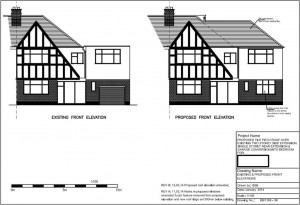Building Regulations - Expert Advice
Professional guidance on Building Regs applications & complianceSimply fill in a few brief details below to find local professionals who can advise you on complying with the Building Regulations.
It only takes a few seconds to appear on your screen. You can then contact them directly to discuss your specific requirements.
This is a FREE service to use.
Click here if you want specialist advice on Planning Permission
When do the Building Regulations apply?
The Building Regulations apply to most building work. Their key aim is to ensure that buildings are safe – and aren’t in danger of collapsing, burning down or generally killing and injuring people. This is achieved by the legal requirement for designers and builders to comply with the ‘approved documents’ which spell out the details.
Building Regultions are also concerned with matters such as minimising heat loss from buildings by conserving energy, and ensuring people with disabilities can access and move around inside buildings. Scotland has a separate set of Building Regulations from England & Wales.
For all but the smallest works you normally need to make a ‘full plans’ application in advance with detailed drawings and structural engineer’s calculations. These drawings are much more detailed than the one submitted for planning permission, so you need a professional designer who can advise you. Completing the form above will give you the contact details of local designers.
 Image copyright DCLG
Image copyright DCLG
What is “Building Work”?
The most common works where the Building Regs apply are:-
Structural alterations
Anything that buildings or people depend on for support counts as ‘structural’. So the construction, removal or alteration of any load-bearing element (such as lintels over doors and windows) must be notified in advance to Building Control. The most common structural alterations are ‘knocking through’ internal walls or removing chimney breasts, or installing new lintels, cutting new openings for doorways or windows, or enlarging existing openings.
Extensions and conversions
New building work, such as adding extensions, altering roofs or converting lofts, garages or basements will require prior approval from Building Control. The main exemptions are conservatories and porches of less than 30 m2 floor area.
Replacement windows and doors
New windows and exterior door installations must comply with the Building Regs. With newbuild construction this usually gets covered under the main application for the overall development. But where existing windows and doors are replaced, responsibility for compliance with the Building Regulations is normally down to installers authorised to ‘self-certify’ their work and issue completion certificates. For example, contractors registered with FENSA (Fenestration Self Assessment) can self-certify the compliance of replacement window and door installations.
Heating and hot water systems
Heating systems and combustion appliances using gas, oil or solid fuel are classed as ‘controlled services’. Installing, altering or extending them requires consent. Approved installers registered as ‘competent persons’ can self-certify that work has been carried out in compliance with the Building Regulations. Anything involving gas must by law only be carried out by qualified GAS SAFE registered contractors who can issue certificates for installations and alterations to gas, hot water and heating systems. OFTEC is the equivalent body for oil fired boilers and appliances, and HETAS for solid fuel boilers and appliances.
Electrical works
Electricians registered as ‘competent persons’ can self-certify that their installations comply with the Building Regs. They need to be affiliated to a professional body (such as NICEIC) which confers the necessary ‘registered installer’ status for them to issue compliance certificates. New electrical work must comply with Part P of the Building Regulations.
Insulation
Meeting thermal efficiency standards to minimise heat loss is now a major part of any design. This is covered in Approved Document L1B.
This doesn’t just apply to new homes. Some types of refurbishment work trigger a requirement to upgrade the insulation in existing homes. This applies where you alter or improve more than 50% of the surface area of part of the building’s exterior shell (aka ‘thermal envelope’) i.e. its external walls, roof, windows and doors or ground floor.
Typical works might be when you render, re-plaster or clad an existing wall. You then have to upgrade the surface of the wall or roof etc to meet specified heat loss standards, normally by adding extra insulation. This rule can be fairly complex to get a handle on because the requirement also kicks in where more than 25% of the entire surface area of the whole ‘envelope’ is renovated.
Roofs
Making like-for-like alterations, such as changing a few roof tiles with matching new ones, doesn’t need consent. But the ‘50% rule’ comes into play where there’s ‘substantial removal of roof coverings’ (ie more than 50 per cent). Any alterations to the roof structure, such as cutting through structural timbers, adding dormer windows, or changing the shape or height will need consent.
Floors and ceilings
Alterations such as replacing ceiling joists or suspended timber floor members count as structural and need consent. However running new pipes and cables through joists shouldn’t need consent.
Stairs
All new stairs must comply. However there is no requirement to upgrade old buildings to comply with current standards (apart from thermal efficiency in some cases). So even steep and narrow staircases with limited headroom can usually be retained, although it makes sense to install basic safety features such as handrails. But consent will be required where alterations are made to existing stairs or where they are relocated.
Other works
Other types of ‘Building Work’ that need consent include new drainage, inserting cavity wall insulation, underpinning the foundations of a building, and changing a building’s use (e.g. conversions). In many cases installers may be able to ‘self-certify’ the work.
Filling in the form above will instantly give you a list of people who can advise you – a mix of Building Surveyors, Structural Engineers, Architects and other specialists familiar and experienced with Building Regulations requirements. In addition to their contact details you will also see details of their experience and qualifications to help select the right service for your requirements.
It’s a good idea to initially phone to discuss your requirements. Before making a firm appointment get them to confirm that their professioanl indemnity insurance (PII), qualifications and experience are appropriate for the level of service required.
If you do need help with a Planning Permission Application, please click here.
What if I don’t apply for Building Regs?
If you carry out relevant ‘Building Work’ without consent you can be open to prosecution, resulting in heavy fines and also made to demolish the work in question.
Without the necessary ‘Completion Certificate’ from Building Control it will be difficult to sell or even re-mortgage a property. At best, lenders may only be willing to release funding on the condition that you apply for a ‘certificate of regularisation’. This involves Building Control retrospectively inspecting the property once the work in question has been ‘opened up’ by your builders so that it’s clearly visible. There are three possible outcomes: approval, where the work complies; rectification, where it doesn’t comply; or re-instatement, where it isn’t possible to rectify things.
![]()


